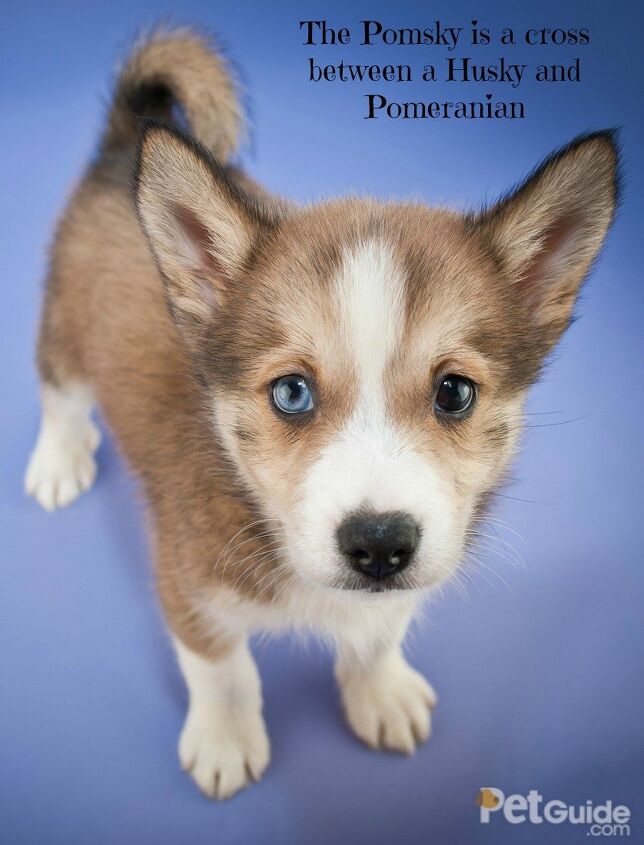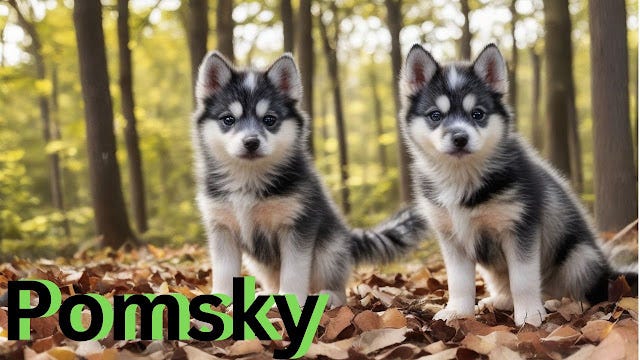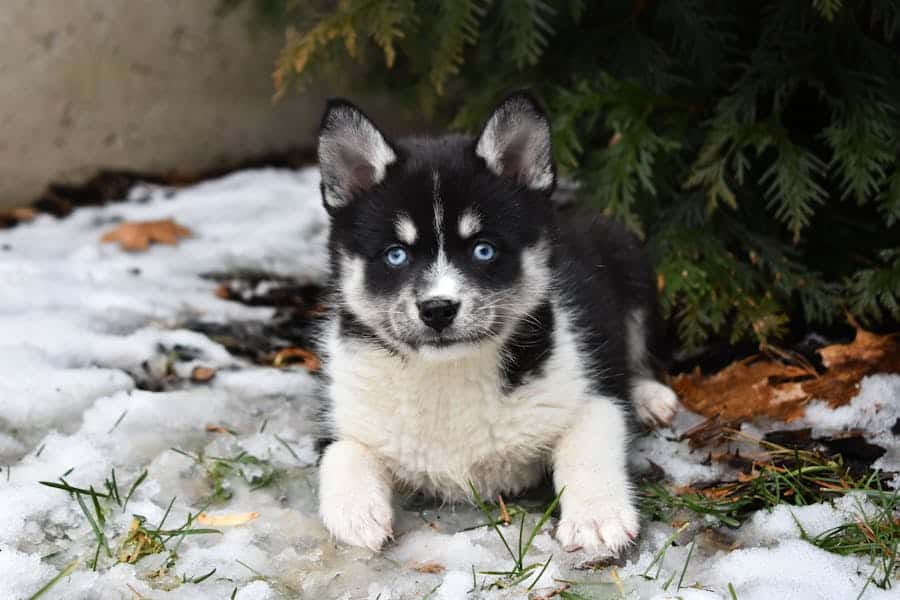Pomskies are a crossbreed of Pomeranians and Siberian Huskies, while Pomeranians are a purebred toy breed. Pomskies typically exhibit a mix of both parent breeds’ traits.
Deciding between a Pomsky and a Pomeranian is a choice between two very different canine companions. Pomskies bring the compact size of Pomeranians together with the Husky’s wolf-like features, creating a unique, intelligent, and energetic hybrid. They can vary significantly in size and appearance.
On the other hand, Pomeranians are renowned for their fluffy coats and small stature, making them ideal for apartment living and owners who prefer a less vigorous pet. Both breeds share a charisma that can win hearts but come with distinct care needs, activity levels, and grooming requirements. Your preference in size, energy levels, and maintenance will greatly influence your decision. Understanding these breeds’ characteristics will guide dog lovers to the right furry friend for their lifestyles.
Introduction To Pomskies And Pomeranians
Dive into the enchanting world of fluffy companions with Pomskies and Pomeranians. These breeds capture hearts with their adorable looks and lively personalities. Understanding these charming canines leads to a rewarding pet experience. Let’s explore what makes these breeds special and irresistible.
The Rising Popularity Of Hybrid Breeds
Hybrid dog breeds like the Pomsky have recently gained fame. These breeds mix traits of purebred parents for unique combinations. The Pomsky, a blend of Pomeranian spunk and Siberian Husky strength, showcases this trend. Their rising popularity stems from their striking appearance and manageable size.
Pomeranian: The Tiny Bundle Of Joy
The Pomeranian greets the world with boundless energy and a brave heart. This tiny breed, known for its luxurious fur coat and fox-like features, brings joy to families. Their compact size makes them ideal companions for city dwellers and those with limited space.
Origins And Breeding History
Delving into the past of two adorable breeds, the Pomsky and the Pomeranian, paints a picture of diverse heritage and selective breeding. Each breed boasts a unique tapestry interwoven with intriguing ancestries and rich histories.
The Arctic Ancestry of the Pomsky
The Arctic Ancestry Of The Pomsky
The Pomsky merges the endurance of Huskies with the tininess of Pomeranians. This hybrid dog is a fairly new addition to the canine world.
- Husky Heritage: Sled-pulling Huskies from the Arctic contribute to the Pomsky’s vigor and resilience.
- Pomeranian Mix: Adding a Pomeranian parent brings down their size and injects a dose of playful charm.
- Designer Dog Appeal: Pomskies were bred for those wanting a Husky’s look in a compact size.
Pomeranian: A Royal Favorite Through Time
The Pomeranian’s tale stretches back to favored companions of royalty. Their lineage is adorned with tales of luxury and admiration.
| Century | Notability |
|---|---|
| 18th | Queens and kings chose Pomeranians as beloved pets. |
| 19th | The breed shrunk in size but grew in popularity. |
| 20th & 21st | Modern Pomeranians became smaller, fluffier, and widely cherished. |
From Courts to Couches: This breed made an elegant transition from regal courts to being a favorite among the masses.
Physical Attributes Compared
Pomskies and Pomeranians captivate hearts with their adorable looks. Yet, their physical traits differ. Each breed boasts unique features that appeal to pet lovers. Let’s dive into their physical characteristics, comparing size, weight, coat colors, and grooming needs.
Size And Weight: A Contrast
Pomskies are a crossbreed of the larger Husky and the smaller Pomeranian, resulting in a medium-sized dog. Pomeranians, on the other hand, are part of the toy breed group. This makes them distinct in both size and weight.
| Breed | Height | Weight |
|---|---|---|
| Pomsky | 10 to 15 inches | 20 to 30 pounds |
| Pomeranian | 6 to 7 inches | 3 to 7 pounds |
Clearly, Pomskies are bigger and heavier than Pomeranians. This makes them suited for different living environments and exercise needs.
Coat Colors And Grooming Needs
Both breeds sport lush coats that come in a variety of colors. It is one of their most striking features.
- Pomskies may inherit the Husky’s coat pattern or the Pomeranian’s solid color.
- Pomeranians are known for their vibrant, solid shades ranging from red to orange, cream, and black.
When it comes to grooming, these breeds are high-maintenance. Their double coats require frequent brushing to prevent matting.
- Pomskies often need weekly brushing and occasional baths.
- Pomeranians might require brushing several times a week.
Shedding is common in both breeds, meaning regular grooming is key for a tidy home and a healthy coat.
Temperament And Personality Traits
Choosing between a Pomsky and a Pomeranian isn’t just about looks. These breeds have unique temperaments and personality traits that make them stand out. Let’s delve deeper and discover what makes each breed a special companion in terms of their behavior and character.
Pomsky: The Energetic Companion
The Pomsky is a cross between a Pomeranian and a Siberian Husky. This blend results in a lively and playful dog that thrives on interaction and exercise. Despite their energy, Pomskies also enjoy quality snuggle time with their owners. They exhibit a wonderful balance between vivacity and affection.
- Smart and trainable: Pomskies inherit the intelligence of a Husky.
- Social butterflies: They love meeting new people and pets.
- Awareness: Their alertness makes them excellent watchdogs.
Pomeranian: Confident And Animated Charmer
Pomeranians, with their bold and buoyant personalities, are often described as big dogs in small bodies. They carry themselves with an impressive confidence and exhibit charisma that captivates those around them. True to their nature, Pomeranians are intelligent and eager to learn, making them delightful to train.
- Attention seekers: Pomeranians crave and enjoy the spotlight.
- Cheerful: Their upbeat attitude lightens up any room.
- Loyal: They form deep connections with their owner.
Both breeds share joyous dispositions but cater to different lifestyles. A Pomsky’s vigor suits active individuals while a Pomeranian’s charm fits those seeking an affectionate and spirited friend.
Training And Intelligence
When choosing between a Pomsky and a Pomeranian, understanding their training and intelligence helps. Both breeds are smart, but they learn differently. Let’s dive into how trainable these fluffy companions are.
Trainability Of Pomskies
Pomskies, a mix of Pomeranians and Huskies, show diverse training traits. Intelligent but stubborn, they benefit from firm, consistent training. Early socialization is key. With their Husky lineage, Pomskies have a wild streak. But, they respond well to positive reinforcement. Use treats and praises to keep them engaged. Regular training sessions prevent boredom. Patient and creative techniques work best.
- Begin training early: As puppies, Pomskies soak up lessons well.
- Stay consistent: These dogs thrive on routine and clear rules.
- Use positive rewards: Treats, toys, and praise keep Pomskies motivated.
- Include play in training: This makes learning fun for them.
The Smart And Teachable Pomeranian
On the other hand, Pomeranians are eager to please. Their size and eagerness make them excellent for obedience training. Intelligence shines in Pomeranians as they learn tricks and commands with ease. Training should start early to establish behaviors. Short, engaging sessions prevent losing their attention. Reward-based methods build positive associations with learning.
| Training Tip | Effectiveness |
|---|---|
| Keep it short and sweet | High |
| Use rewards | Very High |
| Be patient and consistent | Essential |
| Start early | Crucial |
Remember, with both Pomskies and Pomeranians, patience and understanding go a long way. Bond with your pet and enjoy the training journey!
Exercise And Activity Levels
Understanding the exercise and activity levels of our furry friends is crucial for their well-being. Different breeds have distinct needs that must be met for a happy, healthy life. Let’s explore the activity requirements of Pomskies and Pomeranians, two popular breeds that differ notably in their exercise demands.
Pomsky: Keeping Up With Vigorous Activity
Pomskies, a crossbreed of the Siberian Husky and Pomeranian, are powerhouses of energy. They inherit the Husky’s drive for consistent, vigorous exercise. Fulfilling their need for activity is critical for both their physical and mental health.
- Daily walks are essential, lasting at least 30 minutes.
- They love playtime in open spaces like parks.
- Interactive games such as fetch will keep them engaged and content.
- Training agility courses can be a fun way to burn excess energy.
A regular exercise schedule prevents a Pomsky from becoming restless or developing destructive behaviors.
Exercise Needs Of A Pomeranian
Pomeranians, with their fluff and pomp, might seem like they’re made for relaxation. Yet, these tiny canines have a zest for life and enjoy staying active. Their exercise needs are less intensive compared to Pomskies.
- Short, daily walks of 15-20 minutes are sufficient.
- Indoor play can often meet their exercise needs.
- They love engaging in games that challenge their minds.
Ensuring Pomeranians get regular, moderate exercise helps maintain their weight and keeps them jovial.
| Pomsky | Pomeranian |
|---|---|
| 30+ minutes of exercise daily | 15-20 minutes of exercise daily |
| Enjoys outdoor activities and games | Prefers indoor play and mental challenges |
| Needs space to run and explore | Can exercise even in small spaces |
Health And Lifespan Considerations
When choosing between a Pomsky and a Pomeranian, understanding their health and expected lifespan is crucial. Both breeds may face genetic health challenges that potential owners should be aware of. Early knowledge of these issues allows for better care and a potentially longer, happier life for your furry companion.
Common Genetic Health Issues In Pomskies
Pomskies, a mix of Pomeranian and Husky, often inherit traits from both breeds. This mixed heritage can bring unique health concerns. Some common issues Pomskies might face include:
- Dental Problems: Due to their smaller jaw, they may suffer from teeth overcrowding.
- Eye Conditions: Likelihood of cataracts and corneal dystrophy.
- Joint Issues: Hip dysplasia can be a concern due to their Husky lineage.
Regular vet check-ups are vital to catch these issues early.
Preventive care is the best step for a healthy life.
Pomeranian: Potential Health Concerns And Care
Pomeranians are known for their fluffy coats and lively personalities. However, they also have specific health considerations.
| Health Concern | Preventive Measures |
|---|---|
| Luxating Patella | Regular exercise and proper diet. |
| Tracheal Collapse | Avoiding harsh collars, use a harness. |
| Skin Issues | Regular grooming and flea control. |
The lifespan of Pomeranians typically ranges from 12 to 16 years.
They need consistent care and affection for a life full of vitality.

Credit: www.petguide.com
The Ideal Home Environment
Finding the right dog breed for your home requires thought. Families looking for furry friends often compare Pomskies and Pomeranians. Let’s explore which dog may best suit your environment.
Which Breed Fits Your Lifestyle?
Different breeds, different needs. Think about how much time you can spend with your pet.
- Pomskies need active playtime.
- Pomeranians enjoy short, fun activities.
Space Considerations For Pomskies And Pomeranians
Your living space matters too.
| Breed | Indoor Space | Outdoor Space |
|---|---|---|
| Pomsky | Medium to large rooms | Yard for exercise is ideal |
| Pomeranian | Cozy spaces work well | Small or no yard works |
Remember, small apartments suit Pomeranians best. Larger spaces with yards can keep Pomskies happy and healthy.
Cost Of Ownership And Budgeting
Bringing a furry friend into your home is exciting. But each breed has unique costs. Let’s compare Pomskies to Pomeranians in terms of the budget.
Pomsky: A Pricey Investment
Pomskies blend Pomeranian charm with Siberian Husky grandeur. This mix raises their value. The initial price tag for a Pomsky is steep. Expect to pay between $2,000 to $5,000 for one.
However, purchasing is just the beginning. This table shows typical first-year costs:
| Item | Cost |
|---|---|
| Initial Veterinary Visits | $150-$300 |
| Vaccinations | $75-$100 |
| Spaying/Neutering | $200-$500 |
| Food | $250-$700 |
| Grooming | $30-$500 |
| Miscellaneous | $200-$500 |
Don’t forget annual costs like food, vet visits, and insurance. A Pomsky can cost $1,000-$3,000 yearly after the first year.
Owning A Pomeranian: Expenses To Expect
Pomeranians are small but come with ongoing expenses. The purchase price can range from $500 to $1,500.
- Vet visits: $45-$200 each
- Vaccinations: $75-$100 annually
- Grooming: $30-$100 per session
While generally healthy, Pomeranians may need special care for their fluffy coats and possible dental issues. Budget for dental cleanings and grooming tools.
Factor in quality dog food, treats, and toys. Yearly costs for a Pomeranian can range $1,000-$2,000.
Both breeds require a commitment not just of love and time, but of resources too. Proper budgeting ensures your pet lives a happy, healthy life.
Making The Final Choice
Imagine finding a furry friend who fits perfectly with your lifestyle. That choice often narrows down to two adorable breeds: the Pomsky and the Pomeranian. Understanding their differences is key to making the best decision. The Pomsky, a mix between a Siberian Husky and a Pomeranian, offers a unique blend of both breeds’ traits. The purebred Pomeranian, famous for its tiny size and big personality, has its own charm. This section will explore the pros and cons of each breed, helping you decide on your ideal pet.
Pros And Cons: Pomsky Vs. Pomeranian
| Pomsky | Pomeranian |
|---|---|
|
|
|
|
Meeting Your Match: Selecting The Perfect Companion
Selecting a pet requires aligning their traits with your lifestyle. Consider your living situation. Do you have enough room for a Pomsky or would a smaller Pomeranian suit better? Think about grooming and exercise needs. Are you ready for regular brushing sessions and daily walks?
Let’s dig deeper:
- Activity Levels: Pomskies burst with energy and thrive with active owners. Pomeranians need less room to roam and can be content with indoor play.
- Space Requirements: Pomeranians adapt easily to apartment living. Pomskies may desire more space due to their larger size.
- Training Commitment: Both breeds benefit from early training. Consistency is key to raising a well-behaved dog.
Examining your daily routine ensures you choose a pet that integrates seamlessly into your life. Talk to breeders, meet adult dogs, and learn about each breed’s disposition. Your final choice should bring joy and companionship for years to come.
Conclusion: A Furry Friend For Life
Choosing between a Pomsky and a Pomeranian is more than picking a pet. It’s about finding a new family member that will bring warmth and joy to your home. Both breeds have their unique charm, but their loving nature is what makes them a lifelong furry friend.
Reflecting On The Heartwarming Qualities
Pomskies, with their striking eyes and fluffy coats, are mixtures of energy and snuggles. Here lies a quick glance at why they stand out:
- Husky-like appearance that captures hearts
- Playful spirits full of spunk and excitement
- A blend of Pomeranian and Husky traits making them unique
Pomeranians, the original bundles of fluff, steal the show with:
- A small size perfect for lap cuddles
- Lively personalities that fill rooms with joy
- Devotion and affection towards their owners
Adopt Responsibly: A Commitment To Care
Bringing a Pomsky or Pomeranian home is a vow to provide a lifetime of love and attention. They depend on you for:
| Needs | Pomsky | Pomeranian |
|---|---|---|
| Exercise | High | Moderate |
| Grooming | Regular | Frequent |
| Training | Consistent | Persistent |
| Attention | Plenty | Loads |
Both breeds desire companionship and love. Remember, when you adopt, you promise to be their guardian for all their days. Choose wisely and readiness to nurture these loving creatures is key.

Credit: medium.com
Frequently Asked Questions For Pomsky Vs Pomeranian
What Are The Cons Of A Pomsky?
Pomskies may inherit stubbornness and high energy levels, requiring consistent training and exercise. Their thick coats demand regular grooming. Being a hybrid, they also potentially face health issues linked to their Pomeranian and Husky lineage.
Why Is My Pomsky So Aggressive?
Your Pomsky may be aggressive due to lack of training, socialization, fear, territorial behavior, or underlying medical issues. Consult a veterinarian or a professional dog trainer for tailored advice on managing aggression.
Are Pomskies High Maintenance?
Yes, Pomskies can be high maintenance due to their energy levels and need for regular grooming, exercise, and attention.
Why Are Pomsky Puppies So Expensive?
Pomsky puppies are expensive due to their popularity, the cost of breeding smaller dogs, and high demand. Their unique wolf-like appearance and smaller size from Husky and Pomeranian lineage contribute to their premium price.
Conclusion
Selecting between a Pomsky and a Pomeranian is a choice full of delight. Each breed offers distinct charms and challenges. Your personal lifestyle, space, and time commitment will tip the scales. A Pomsky’s dynamism contrasts with a Pomeranian’s regal demeanor.
Make your decision with care, cherishing the unique joy these furry friends bring to your life.

